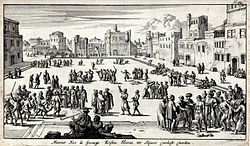Slavery on the Barbary Coast refers to the enslavement of people taken captive by the Barbary corsairs of North Africa.

According to Robert Davis, author of Christian Slaves, Muslim Masters, between 1 million and 1.2 million Europeans were captured by Barbary pirates and sold as slaves in North Africa and The Ottoman Empire between the 16th and 19th centuries.[1]
From bases on the Barbary coast of North Africa, the Barbary pirates raided ships traveling through the Mediterranean and along the northern and western coasts of Africa, plundering their cargo and enslaving the people they captured. From 1500 onward, pirates also conducted raids along seaside towns of Italy, Spain, France, England and as far away as Iceland, capturing men, women and children. On some occasions, settlements such as Baltimore, Ireland were abandoned following Barbary pirate raids, only being resettled many years later. Between 1609 and 1616, England alone lost 466 merchant ships to Barbary pirates.[2]
Barbary wars
editCommercial ships from the United States of America were subject to pirate attacks. In 1783, the United States made peace with, and gained recognition from, the British monarchy. In 1784, the first American ship was seized by pirates from Morocco. By late 1793, a dozen American ships had been captured, goods stripped, and all passengers and crew enslaved. In response, the US created the United States Navy in March 1794.[3]
This new military presence helped stiffen American resolve to resist the continuation of tribute payments, leading to the two Barbary Wars along the North African coast: the First Barbary War from 1801 to 1805 and the Second Barbary War in 1815.[3] Payments of ransom and tribute to the Barbary states were 20% of United States government annual revenues in 1800.[4] It was not until 1815 that naval victories ended tribute payments by the United States. Some European nations continued annual payments until the 1830s.[5] The white slave trade and slave markets in the Mediterranean gradually declined and eventually disappeared after European occupations.[6]
Slave narratives
editIn comparison to North American and Caribbean slave narratives, the North African slave narratives in English were written by British and American white slaves captured (at sea or by Barbary pirates) and enslaved in North Africa in the 18th and early 19th centuries. They are distinct in that they highlight the non-Christian aspect of Muslim slave traders.
Narratives that focused on the central themes of freedom and liberty drew inspiration from the American Revolution. Since surviving narratives include recurrences of certain themes and quote each other, some scholars believe that accounts were derivative of prior narratives.[7]
Examples include:
- Horrors of slavery: or, The American tars in Tripoli, by Ray William, 1808[8]
- Charles Sumner (1847). White Slavery in the Barbary States: A lecture before the Boston Mercantile Library Association. ISBN 9781092289818.
- A True and Faithful Account of the Religion and Manners of the Mahometans by Joseph Pitts (1663–1735) Pitts was captured as a boy aged 14 by Barbary pirates off the coast of Spain. His sale as a slave and his life under three different masters in North Africa, and his travels to Mecca are described.
- Tyrkja-Gudda, Símonardóttir was abducted from her home in Iceland by Barbary pirates in 1627
- Thomas Pellow, The History of the Long Captivity and Adventures of Thomas Pellow, In South Barbary, 1740
- A Journal of the Captivity and Suffering of John Foss; Several Years a Prisoner in Algiers, 1798[9]
- History of the Captivity and Sufferings of Mrs Maria Martin who was six years a slave in Algiers 1812[10]
- Captain James Riley, Sufferings in Africa, 1815
- The Narrative of Robert Adams, An American Sailor who was wrecked on the West Coast of Africa in the year 1810 and was detained three years in slavery by the Arabs of the great desert, 1817
- James Leander Cathcart, The Captives, Eleven Years a Prisoner in Algiers, published in 1899, years after his captivity in Ottoman Algeria
See also
editReferences
edit- ^ "When Europeans Were Slaves: Research Suggests White Slavery Was Much More Common Than Previously Believed". news.osu.edu. Columbus, Ohio: Ohio State University. 7 March 2004. Archived from the original on 2011-07-25. Retrieved 25 March 2024.
- ^ Davies, Rees (1 July 2003). "British History in depth: British Slaves on the Barbary Coast". www.bbc.co.uk. BBC. Retrieved 25 March 2024.
- ^ a b The Mariners' Museum: The Barbary Wars, 1801-1805
- ^ Oren, Michael B. (2005-11-03). "The Middle East and the Making of the United States, 1776 to 1815". Retrieved 2007-02-18.
- ^ Richard Leiby, "Terrorists by Another Name: The Barbary Pirates", The Washington Post, October 15, 2001
- ^ The Cambridge World History of Slavery: Volume 3, AD 1420–AD 1804
- ^ Papadopoulou, Nikoletta (2017). "The narrative's 'general truth': Authenticity and the mediation of violence in Barbary captivity narratives". European Journal of American Culture. 36 (3): 209–223. doi:10.1386/ejac.36.3.209_1.
- ^ William, Ray (1808). "Horrors of slavery: or, The American tars in Tripoli. Containing an account of the loss and capture of the United States frigate Philadelphia; treatment and sufferings of the prisoners". lib.umich.edu. Retrieved 25 March 2024.
- ^ Wood, Sarah F. (2005). Quixotic Fictions of the USA, 1792-1815. Oxford: Oxford University Press. pp. 119–120. ISBN 9780199273157.
- ^ Martin, Maria (1812). History of the captivity and sufferings of Maria Martin, who was six years a slave in Algiers. To which is added a concise history of Algiers.
External links
edit- Carroll, Rory (2004-03-11). "New book reopens old arguments about slave raids on Europe". The Guardian. ISSN 0261-3077. Retrieved 2017-12-11.